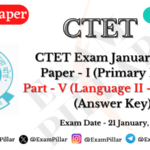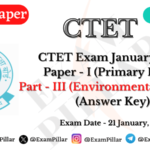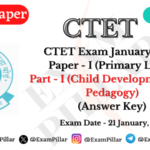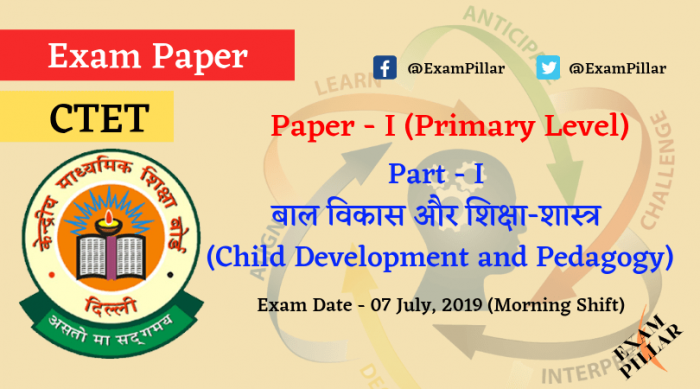CBSE conducted the CTET (Central Teacher Eligibility Test) Exam Paper held on 07th July 2019 Evening Shift. Here The CTET Paper – II Part – I Child Development and Pedagogy Question Paper with Answer Key. CTET July 2019 Answer Key.
CTET (Central Teachers Eligibility Test)
Paper – II Junior Level (Class 6 to Class 8)
Exam – CTET Paper II Junior Level (Class VI to VIII)
Part – Part – I Child Development and Pedagogy
Organized – CBSE
Number of Question – 30
Paper Set – Y
Exam Date) – 07th July 2019 (Evening Shift 02.00 PM – 04.30 PM)
Read Also …
- CTET 2019 Paper – II – Part – I – बाल विकास और शिक्षा-शास्त्र (हिंदी)
- CTET 2019 Paper – II – Part – II – गणित और विज्ञान (Mathematics and Science)
- CTET 2019 Paper – II – Part – III – सामाजिक अध्ययन / सामाजिक विज्ञान (Social Studies/Social Science)
- CTET 2019 Paper – II – Part – IV – Language – I (English)
- CTET 2019 Paper – II – Part – IV – Language – I हिंदी (Hindi)
- CTET 2019 Paper – II – Part – V – Language – II (English)
- CTET 2019 Paper – II – Part – V – Language – II हिंदी (Hindi)
CTET Exam July 2019 Paper – 2 (Junior Level)
Part – I Child Development and Pedagogy
Click Here To Read This Paper in Hindi
Directions : Answer the following questions (Q. Nos. 1 to 30) by selecting the correct/most appropriate options.
1. A teacher should encourage students to set ______ rather than _____.
(1) failure avoiding goals; marks seeking goals
(2) marks seeking goals; failure avoiding goals
(3) learning goals; performance goals
(4) performance goals; learning goals
Show Answer/Hide
2. Which of the following does not result in meaningful facilitation of learning ?
(1) Use of examples and non examples
(2) Encouraging multiple ways of looking at a problem
(3) Connecting new knowledge to pre-existing knowledge
(4) Promoting repetition and recall
Show Answer/Hide
3. Which of the following would not be consistent with a constructivist environment ?
(1) Teachers elicit students’ ideas and experiences in relationship to key topics and plant teaching-learning to elaborate or restructure their current knowledge.
(2) Teachers employ, specific end of the term assessment strategies and give feedback on products rather than processes.
(3) Students are given frequent opportunities to engage in complex, meaningful, problem-based activities.
(4) Students work collaboratively and are given support to engage in tsak oriented dialogue with each other.
Show Answer/Hide
4. In a primary classroom a teacher should
(1) give both examples and non examples
(2) not give any examples and non examples give
(3) only examples
(4) give only non-examples
Show Answer/Hide
5. Which of the following strategies would promote meaning-making in children ?
(1) Using punitive measures
(2) Uniform and standardized testing
(3) Exploration and discussion
(4) Transmission of information
Show Answer/Hide
6. Which of the following are examples of effective learning strategies ?
(i) Setting goals and time tables
(ii) Making organizational charts and concept maps
(iii) Thinking of examples and nonexamples
(iv) Explaining to a peer
(v) Self-questioning
(1) (i), (ii), (iii), (v)
(2) (i), (ii), (iii), (iv), (v)
(3) (i), (ii), (iii)
(4) (i), (iv), (v)
Show Answer/Hide
7. Which of these is an example of extrinsic motivation ?
(1) “Doing homework makes me understand my concepts better.”
(2) “I complete my homework because the teacher gives us marks for each assignment.”
(3) “I enjoy doing my homework because it is so much fun.”
(4) “I learn so much when I do my homework.”
Show Answer/Hide
8. A teacher’s role while using cooperative learning in her class –
(1) is to be supportive and monitor each group.
(2) is to support the group which has the ‘bright’ and ‘talented’ children.
(3) is to be a silent spectator and let children do what they want.
(4) is to leave the class and let children work on their own.
Show Answer/Hide
9. Children’s errors and misconceptions –
(1) should be ignored in the teaching learning process.
(2) signify that children’s capabilities are far inferior than that of adults.
(3) are a significant step in the teaching-learning process
(4) are a hindrance and obstacle to the teaching-learning process.
Show Answer/Hide
10. In the constructivist frame child is viewed as
(1) a ‘passive being’ who can be shaped and molded into any form through conditioning.
(2) a ‘problem solver’ and a ‘scientific investigator’.
(3) miniature adult who is less than adult in all aspects such as size, cognition, emotions.
(4) ‘tabula rasa’ or ‘blank slate’ whose life is shaped entirely by experience. malor.
Show Answer/Hide
11. “With an appropriate question/ suggestion, the child’s understanding can be extended far beyond the point which she could have reached alone.” Which construct does the above statement highlight ?
(1) Conservation
(2) Intelligence
(3) Zone of proximal development
(4) Equilibration
Show Answer/Hide
12. According to Lev Vygotsky, basic mental capacities are transformed into higher cognitive processes primarily through
(1) stimulus-response association
(2) adaptation and organization
(3) rewards and punishment
(4) social interaction
Show Answer/Hide
13. Which of the following statements denotes the relationship between development and learning correctly?
(1) Rate of learning far exceeds the rate of development.
(2) Development and learning are inter-related and inter-dependent.
(3) Development and learning are not related.
(4) Learning takes place irrespective of development.
Show Answer/Hide
14. According to Piaget, specific psychological structures (organized ways of making sense of experience) are called
(1) images
(2) mental maps
(3) mental tools
(4) schemes
Show Answer/Hide
15. Constructivists such as Jean Piaget and Lev Vygotsky view learning as.
(1) passive repetitive process
(2) process of meaning-making by active engagement
(3) acquisition of skills
(4) conditioning of responses
Show Answer/Hide





